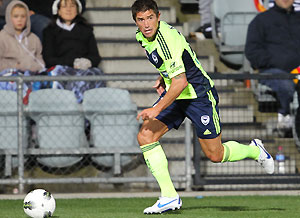
Melbourne Victory's Harry Kewell runs away with the ball against Aelaide United in a pre-season friendly in Adelaide (AAP Image/James Elsby)
For last few weeks I’ve agonised over my 2011-2012 A-League predictions, trying to put the 10 clubs in order of how they’ll finish the home and away season, and picking the grand finalists and eventual winner.
At one point or another Brisbane Roar, Central Coast Mariners, Adelaide United and Melbourne Victory have occupied top spot and had grand final berths. Down the other end of the table, Wellington Phoenix, Gold Coast United and Newcastle Jets have all had a spell at the bottom.
The rest occupied the middle of the ladder – not quite good enough for the Premier’s Plate yet still in finals contention.
So when trying to put the 10 in order, what I found was while their exact positions may have changed, there were three clear groups that could be easily distinguished.
Consider it like it’s a Formula One qualifying session. For the uninitiated, F1 qualifying is divided into three elimination sessions. The slower stragglers are eliminated in the first session, Q1. Next its Q2’s job to eliminate a further group of drivers before the fastest go through to Q3 to determine the pole-sitter.
Here is how my A-League 2011-12 ‘qualifying results’ look:
Q3 (1st to 4th):
Melbourne Victory
Adelaide United
Brisbane Roar
Central Coast Mariners
Q2 (5th to 7th):
Sydney FC
Melbourne Heart
Perth Glory
Q1 (8th to 10th):
Gold Coast United
Wellington Phoenix
Newcastle Jets
Now for the justifications…
Of the Q1 stragglers, there simply isn’t the depth of squad, recognised stars who can change a game (Paul Ifill and Jason Culina could be considered such, but injury rules out the latter and hangs over the former).
Any chance Newcastle had of getting out of Q1 could have evaporated with Branko Culina’s sacking on the brink of the season. Without a marquee (unless Jason Culina’s contract can be torn up and a replacement acquired) and losing a coach so late into preparations, the Jets appears to be in some trouble.
However, the three cellar dwellers are more than capable of upsetting the Q2 and Q3 clubs on their day.
Wellington can always rely on strong home form, even when struggling on the park – although the less congested calendar and reduction in midweek games will help other teams’ preparations for the trip across the ditch.
On the Gold Coast, there may be question marks around the depth in the squad and the lack of experience, but Miron Bleiberg is the coach to graft out results.
Newcastle will be buoyed by big home crowds if the close to 10,000 members show up on a regular basis, while owner Nathan Tinkler has the financial might to splash out on much-needed replacement for Culina (if he’s allowed to) or guest players to try and fill the void.
Of the Q2 clubs, Heart, Perth and Sydney have more star power than the Q3 clubs – players such as Fred (if he’s still as good as his Victory days), Shane Smeltz and Brett Emerton can turn matches on their own, and all three clubs have solid squads.
Yet there are serious question marks over all three.
Does Perth have the pedigree and coaching staff to avoid another wasted season?
Does Heart have the depth across the park and the experience in their sophomore season? And what of those rumours that Simon Colosimo is unhappy at the club, adding further doubts on a defensive line-up that looks a tad shaky.
Does Sydney FC have enough attacking options and have they learnt from the failings of last season?
When compared to the Q3 leaders, there are too many question marks around these three clubs. Crucially, one Q2 will miss the finals – a big blow for all three if that’s case given their high expectations.
Then there are the Q3 leaders: the two pacesetters from last season along with the two clubs that have been the most aggressive and impressive in the transfer market.
Brisbane and Central Coast have retained enough of their talented squads to challenge again this season, and they have plugged the gaps well – in Brisbane’s case, with a great mix of young players who can thrive in that environment.
If any club can buck the trend of challenging for back-to-back triumphs, it’s the club that set a new and incredibly high benchmark last season. Under Ange Postecoglou and playing the sort of football they did last season, they cannot plummet like previous defending champions.
Adelaide United has an incredibly strong spine and will greatly benefit from Jon McKain at the back, while there’s great depth across the park and a sense of unfinished business from last season.
As for Melbourne Victory, my tip to go all the way, the combination of Harry Kewell, Archie Thompson, Danny Allsopp, Jean Carlos Solórzano, Marco Rojas and Carlos Hernandez could tear the league apart – particularly the Archie-Kewell partnership.
That line-up is arguably the best and deepest attacking stock the A-League’s ever seen, and even if there are question marks around their defense, they are more than capable of compensating at the other end.
The A-League is a league in three this season.





























































































